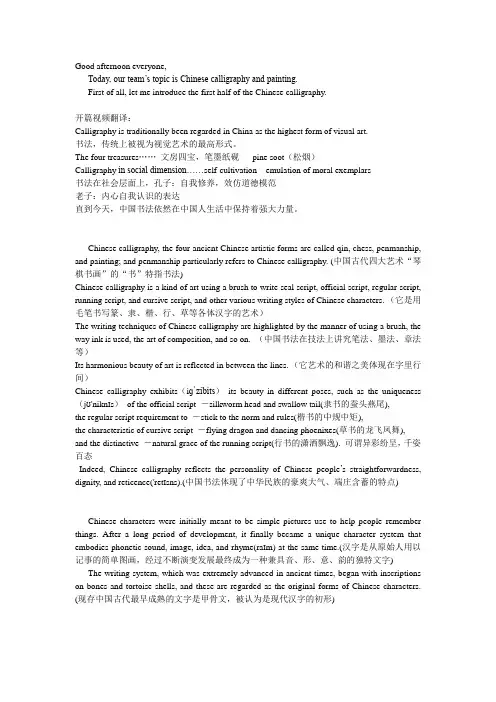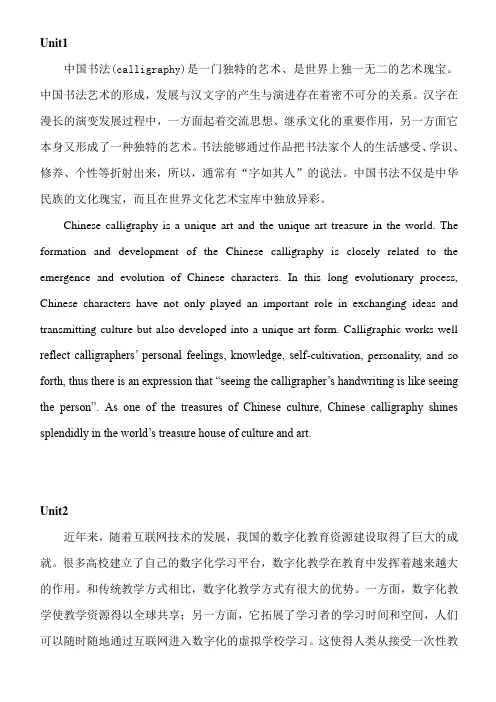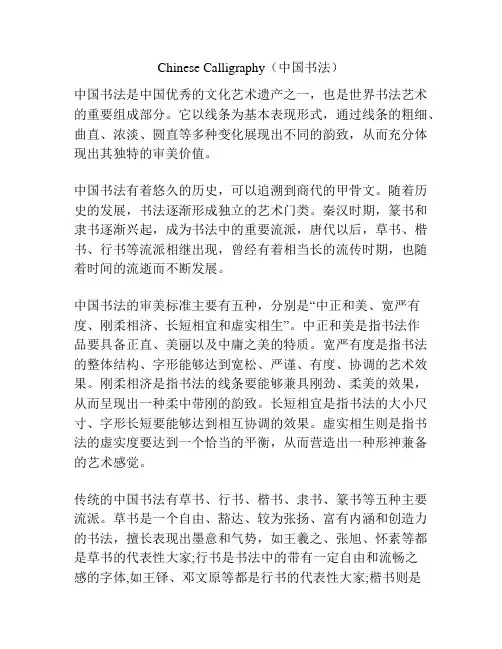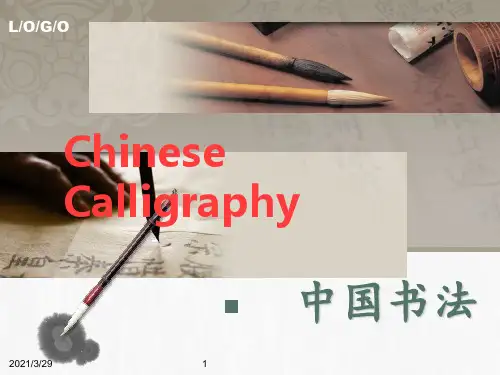中国书法英文翻译
中国书法用英语介绍

中国书法用英语介绍Chinese calligraphy is a traditional art form in China that has a long history and deep cultural significance. It involves the writing of Chinese characters using a brush and ink, with a focus on the aesthetics of the characters and the movement of the brush.Chinese calligraphy is considered one of the highest forms of Chinese art, along with painting, poetry, and music. It is often referred to as "the art of writing" or "the art of the brush" in China. Calligraphy has been practiced in China for thousands of years and has been highly valued for its ability to express the beauty of the written word.There are several different styles of Chinese calligraphy, each with its own unique characteristics and techniques. Some of the most famous calligraphy styles include regular script (楷书), running script (草书), cursive script (行书), and seal script (篆书). Each style has its own rules and conventions, but all are based on the fundamental principles of brush control, stroke order, and balance.One of the key elements of Chinese calligraphy is the use of brush strokes to create expressive and dynamic characters. Calligraphers pay close attention to the thickness, speed, and direction of each stroke, as well as the overall composition of the characters on the page. The result is a work of art that not only conveys the meaning of the text but also embodies the emotions and intentions of the calligrapher.In addition to its artistic value, Chinese calligraphyis also highly regarded for its cultural and spiritual significance. Calligraphy is often used in traditional Chinese ceremonies and rituals, such as weddings, funerals, and the Lunar New Year. It is also considered a form of meditation and self-expression, allowing practitioners to cultivate mindfulness and focus through the practice of writing.Overall, Chinese calligraphy is a rich and complex art form that reflects the beauty, history, and cultural heritage of China. It continues to be practiced and appreciated by people around the world, serving as a bridge between past and present, tradition and modernity.中国书法是中国传统艺术形式之一,具有悠久的历史和深厚的文化内涵。
中国书法英文 chinese calligraphy

Qushui
Lanting : Shaoxin, Zhejiang Province Where Wang Xizhi wrote his world famous work
Master Pieces Calligraphers
• Yan Zhenqing(颜真 卿)
• One of the best calligraphers in Tang Dynasty
• His calligraphy is dignified and magnificent
Master Pieces
• Yan is a famous loyal minister . He fought with the rebel army in “Anshizhiluan”.
• Killed by traitor ministers
Chinese Calligraphy
Calligraphy
• Chinese Calligraphy is a kind of art. It’s occurrence is based on the development of Chinese characters and the culture of China.
Master Pieces
• Former home of Wang Xizhi
• Linyi, Shandong Province
The place where he wash his inkstone
——洗砚池
Master Pieces
• The best Xingshu in the world
Master Pieces
Each character is 68×68
中国书法英文介绍

Good afternoon everyone,Today, our team’s topic is Chinese calligraphy and painting.First of all, let me introduce the first half of the Chinese calligraphy.开篇视频翻译:Calligraphy is traditionally been regarded in China as the highest form of visual art.书法,传统上被视为视觉艺术的最高形式。
The four treasures……文房四宝,笔墨纸砚pine soot(松烟)Calligraphy in social dimension……self-cultivation emulation of moral exemplars书法在社会层面上,孔子:自我修养,效仿道德模范老子:内心自我认识的表达直到今天,中国书法依然在中国人生活中保持着强大力量。
Chinese calligraphy, the four ancient Chinese artistic forms are called qin, chess, penmanship, and painting; and penmanship particularly refers to Chinese calligraphy. (中国古代四大艺术“琴棋书画”的“书”特指书法)Chinese calligraphy is a kind of art using a brush to write seal script, official script, regular script, running script, and cursive script, and other various writing styles of Chinese characters.(它是用毛笔书写篆、隶、楷、行、草等各体汉字的艺术)The writing techniques of Chinese calligraphy are highlighted by the manner of using a brush, the way ink is used, the art of composition, and so on. (中国书法在技法上讲究笔法、墨法、章法等)Its harmonious beauty of art is reflected in between the lines. (它艺术的和谐之美体现在字里行间)Chinese calligraphy exhibits(iɡˈzibits)its beauty in different poses, such as the uniqueness (jʊ'niknɪs)of the official script ―silkworm head and swallow tail(隶书的蚕头燕尾),the regular script requirement to ―stick to the norm and rules(楷书的中规中矩),the characteristic of cursive script ―flying dragon and dancing phoenixes(草书的龙飞凤舞), and the distinctive ―natural grace of the running script(行书的潇洒飘逸).可谓异彩纷呈,千姿百态Indeed, Chinese calligraphy reflects the personality of Chinese people’s straightforwardness, dignity, and reticence('retɪsns).(中国书法体现了中华民族的豪爽大气、端庄含蓄的特点)Chinese characters were initially meant to be simple pictures use to help people remember things. After a long period of development, it finally became a unique character system that embodies phonetic sound, image, idea, and rhyme(raɪm) at the same time.(汉字是从原始人用以记事的简单图画,经过不断演变发展最终成为一种兼具音、形、意、韵的独特文字) The writing system, which was extremely advanced in ancient times, began with inscriptions on bones and tortoise shells, and these are regarded as the original forms of Chinese characters. (现存中国古代最早成熟的文字是甲骨文,被认为是现代汉字的初形)Afterwards, Chinese characters went through numerous calligraphic styles: bronze inscriptions, official script, regular script, cursive script, running script, etc. (此后,汉字又经历了金文、隶书、楷书、草书、行书等不同的阶段)Chinese characters are usually round outside and square inside, which is rooted in ancient Chinese beliefs of an orbicularsky and a rectangular Earth. (汉字结构“内圆外方”,源于古人“天圆地方”的观念)The five basic strokes of Chinese characters are 一(the horizontal stroke), 丨(the vertical stroke), 丿(the left-falling stroke), 捺(the right-falling stroke), and 乙(the turning stroke). (汉字有五种基本笔画,即:横、竖、撇、捺、折)The four treasures of the study.文房四宝The writing brush, ink stick, ink stone, and paper were requisite('rekwɪzɪt)treasures in the study of the scholars of ancient China, and they are often referred to as the ―Four Treasures of the Study.(笔墨纸砚是中国古代文人书房当中必备的宝贝,被称为“文房四宝”)The writing brush and ink stick have been used by the Chinese to write and paint since 5,000 years ago.(用笔墨书写绘画在中国可追溯到五千年前)In the Qin Dynasty (221BC-206BC), people already used feathers('fɛðɚ)of different hardness and bamboo trunks to make brushes.(秦朝时已用不同硬度的毛和竹管制笔)During the Han Dynasty (206BC-220AD), man-made ink was used instead of natural ink. (汉代以人工制墨替代了天然墨)After paper was invented by the Chinese, bamboo slips, wooden tablets, brocade and silk, which originally functioned as writing surfaces, gradually faded out. (有了纸张以后,简牍锦帛逐失其用)The ink stone was first developed with the use of writing brushes and ink. (砚台则随笔墨的使用而发展)After the Song Dynasty(960AD-1279AD), the ―Four Treasures of the Study,particularly referred to hubi, the writing brush produced in Huzhou, Zhejiang province; huimo, the instick produced in Huizhou, Anhui province; xuan paper, a kind of paper produced in Xuanzhou, Anhui province; and duanyan, the ink stone made in Zhaoqing, Guangdong province(Zhaoqing was earlier called Duanzhou).Indeed, the ―Four Treasures of the Study have written the whole Chinese civilization, as it is.“文房四宝”到宋朝(960-1279)以后特指湖笔(浙江湖州)、徽墨(安徽徽州)、宣纸(安徽宣州)、端砚(广东肇庆,古称端州)。
新视野大学英语第三版第二册Units1-5课后翻译汉译英

Unit1中国书法(calligraphy)是一门独特的艺术、是世界上独一无二的艺术瑰宝。
中国书法艺术的形成,发展与汉文字的产生与演进存在着密不可分的关系。
汉字在漫长的演变发展过程中,一方面起着交流思想、继承文化的重要作用,另一方面它本身又形成了一种独特的艺术。
书法能够通过作品把书法家个人的生活感受、学识、修养、个性等折射出来,所以,通常有“字如其人”的说法。
中国书法不仅是中华民族的文化瑰宝,而且在世界文化艺术宝库中独放异彩。
Chinese calligraphy is a unique art and the unique art treasure in the world. The formation and development of the Chinese calligraphy is closely related to the emergence and evolution of Chinese characters. In this long evolutionary process, Chinese characters have not only played an important role in exchanging ideas and transmitting culture but also developed into a unique art form. Calligraphic works well reflect calligraphers’ personal feelings, knowledge, self-cultivation, personality, and so forth, thus there is an expression that “seeing the calligrapher’s handwriting is like seeing the person”. As one of the treasures of Chinese culture, Chinese calligraphy shines splendidly in the world’s treasure house of culture and art.Unit2近年来,随着互联网技术的发展,我国的数字化教育资源建设取得了巨大的成就。
Chinese Calligraphy(中国书法)

Chinese Calligraphy(中国书法)中国书法是中国优秀的文化艺术遗产之一,也是世界书法艺术的重要组成部分。
它以线条为基本表现形式,通过线条的粗细、曲直、浓淡、圆直等多种变化展现出不同的韵致,从而充分体现出其独特的审美价值。
中国书法有着悠久的历史,可以追溯到商代的甲骨文。
随着历史的发展,书法逐渐形成独立的艺术门类。
秦汉时期,篆书和隶书逐渐兴起,成为书法中的重要流派,唐代以后,草书、楷书、行书等流派相继出现,曾经有着相当长的流传时期,也随着时间的流逝而不断发展。
中国书法的审美标准主要有五种,分别是“中正和美、宽严有度、刚柔相济、长短相宜和虚实相生”。
中正和美是指书法作品要具备正直、美丽以及中庸之美的特质。
宽严有度是指书法的整体结构、字形能够达到宽松、严谨、有度、协调的艺术效果。
刚柔相济是指书法的线条要能够兼具刚劲、柔美的效果,从而呈现出一种柔中带刚的韵致。
长短相宜是指书法的大小尺寸、字形长短要能够达到相互协调的效果。
虚实相生则是指书法的虚实度要达到一个恰当的平衡,从而营造出一种形神兼备的艺术感觉。
传统的中国书法有草书、行书、楷书、隶书、篆书等五种主要流派。
草书是一个自由、豁达、较为张扬、富有内涵和创造力的书法,擅长表现出墨意和气势,如王羲之、张旭、怀素等都是草书的代表性大家;行书是书法中的带有一定自由和流畅之感的字体,如王铎、邓文原等都是行书的代表性大家;楷书则是字形端庄、工整,也是我们生活中最常用的书法字体,如欧阳询、颜真卿等都是楷书的代表性大家;隶书是一种秀美流畅的特殊字体,代表性大家有刘羽、刘德等;篆书则是书法的鼻祖,是中国书法艺术发源及演化的根源,代表大家有李斌方、钟繇等。
书法艺术在中国历史文化中占有重要地位。
传统的中国书法教育是以临帖为主的,以模仿、背写古代匠师的佳作为学习的基础,同时,还需要学习笔墨、纸砚等书法用具的使用和文化背景知识,这样才能真正掌握中国书法艺术的精髓。
除了传统的书法教育,现代的书法教育趋于多样化。
中国书法英文 chinese calligraphy优秀课件

This is Former first lady of
American
Laura Bush
2021/3/29
6
Characteristics of Calligraphy
strokes of a Chinese character
2021/3/29
• Linyi, Shandong Province
The place where he wash
his inkstone ——洗砚池
2021/3/29
11
Master Pieces
• The best Xingshu in the world
2021/3/29
12
Master Pieces
• Written when he was drunk
• His writings has almost reached the state of perfection. He Set the model of beauty for Calligraphy learners
2021/3/29
10
Master Pieces
• Former home of Wang Xizhi
7
Characteristics of Calligraphy
Calligraphy and personality
• “The style of handwriting is the man.” • Handwriting often reveals one’s personality.
2021/3/29
• From complicated to simple
英语作文万能模板中国书法
英语作文万能模板中国书法Chinese Calligraphy。
Chinese calligraphy, also known as “Shufa” in Chinese, is a traditional art form that has been practiced for thousands of years. It is not only a means of communication but also a form of artistic expression that embodies the beauty of Chinese culture and language. Chinese calligraphy is highly regarded for its aesthetic value, and it is considered a reflection of the calligrapher’s personality, emotions, and inner thoughts.The history of Chinese calligraphy can be traced back to ancient China, where it was developed as a way to record important events and communicate with others. Over time, it evolved into a highly respected art form that is deeply rooted in Chinese culture. Chinese calligraphy is characterized by its unique brush strokes, use of ink and paper, and emphasis on rhythm and balance. It is often considered a form of meditation, as calligraphers must concentrate and focus their minds while creating their artwork.One of the most important aspects of Chinese calligraphy is the use of the “Four Treasures of the Study,” which include the brush, ink, paper, and inkstone. The brush is typically made from animal hair, such as wolf, rabbit, or goat, and it is used to create the intricate and expressive strokes that are characteristic of Chinese calligraphy. The ink is made from soot and glue, and it is ground on an inkstone and mixed with water to create the perfect consistency for writing. The paper used for calligraphy is often made from rice or mulberry bark, and it is carefully selected for its texture and absorbency.There are several different styles of Chinese calligraphy, each with its own unique characteristics and history. The most well-known styles include seal script, clerical script, regular script, running script, and cursive script. Each style has its own set of rules and techniques, and calligraphers spend years practicing and mastering their chosen style. The art of Chinese calligraphy requires patience, discipline, and a deep understanding of the Chinese language and culture.Chinese calligraphy is not only a visual art form but also a way of preserving and passing down the wisdom and traditions of Chinese culture. It is often used to write poems, historical documents, and philosophical texts, and it is considered an important part of Chinese literature. Calligraphy is also used in traditional Chinese painting, as calligraphers often collaborate with painters to create beautiful and harmonious works of art.In recent years, Chinese calligraphy has gained popularity around the world, and many people from different cultures have become interested in learning this ancient art form. There are now many schools and workshops that offer classes in Chinese calligraphy, and there are also online resources available for those who wish to study on their own. Chinese calligraphy has also been recognized by UNESCO as an intangible cultural heritage, further cementing its importance and influence on the world stage.In conclusion, Chinese calligraphy is a unique and beautiful art form that has played a significant role in Chinese culture for thousands of years. It is a reflection of the Chinese language, history, and traditions, and it continues to be a source of inspiration and admiration for people around the world. As a timeless and revered art form, Chinese calligraphy will undoubtedly continue to captivate and inspire future generations for years to come.。
5 中国书法译文
我很高兴有机会向诸位介绍中国书法这一宝贵的文化遗产。
中国书法和中国绘画一样,是中国传统艺术中最重要的部分。
I am very pleased to have the opportunity to talk about Chinese calligraphy, a highly-valued Chinese cultural heritage. Chinese calligraphy, like Chinese painting, ranks among the most important of traditional Chinese fine arts.中国书法同其他书写形式有很大区别。
许多汉字属象形文字,常常可以从字的形状得知其涵义。
Chinese calligraphy is very different from other forms of writing. Many Chinese characters are pictographs and often the meaning of a particular character is apparent in the pictorial form of the character.汉字在其漫长的发展史中演化成许多不同的艺术形式,其中包括甲骨铭文、青铜器铭文、篆书、隶书、楷书、行书和草书。
During their long history of development Chinese characters have evolved and been written into many different artistic styles, including the inscriptions on bones or tortoise shells and on ancient bronze objects, the seal character, official script, regular script, running script and cursive script.甲骨文被认为是中国最古老的文字,也可以说甲骨文是书法艺术最早的作品。
中国书法英文介绍
Good afternoon everyone,Today, our team’s topic is Chinese calligraphy and painting、First of all, let me introduce the first half of the Chinese calligraphy、开篇视频翻译:Calligraphy is traditionally been regarded in China as the highest form of visual art、书法,传统上被视为视觉艺术的最高形式。
The four treasures……文房四宝,笔墨纸砚pine soot(松烟)Calligraphy in social dimension……self-cultivation emulation of moral exemplars书法在社会层面上,孔子:自我修养,效仿道德模范老子:内心自我认识的表达直到今天,中国书法依然在中国人生活中保持着强大力量。
Chinese calligraphy, the four ancient Chinese artistic forms are called qin, chess, penmanship, and painting; and penmanship particularly refers to Chinese calligraphy、(中国古代四大艺术“琴棋书画”的“书”特指书法)Chinese calligraphy is a kind of art using a brush to write seal script, official script, regular script, running script, and cursive script, and other various writing styles of Chinese characters、(它就是用毛笔书写篆、隶、楷、行、草等各体汉字的艺术)The writing techniques of Chinese calligraphy are highlighted by the manner of using a brush, the way ink is used, the art of composition, and so on、(中国书法在技法上讲究笔法、墨法、章法等)Its harmonious beauty of art is reflected in between the lines、(它艺术的与谐之美体现在字里行间)Chinese calligraphy exhibits(iɡˈzibits) its beauty in different poses, such as the uniqueness(jʊ'niknɪs) of the official script ―silkworm head and swallow tail(隶书的蚕头燕尾), the regular script requirement to ―stick to the norm and rules(楷书的中规中矩),the characteristic of cursive script ―flying dragon and dancing phoenixes(草书的龙飞凤舞), and the distinctive ―natural grace of the running script(行书的潇洒飘逸)、可谓异彩纷呈,千姿百态Indeed, Chinese calligraphy reflects the personality of Chinese people’s straightforwardness, dignity, and reticence('retɪsns)、(中国书法体现了中华民族的豪爽大气、端庄含蓄的特点) Chinese characters were initially meant to be simple pictures use to help people remember things、After a long period of development, it finally became a unique character system that embodies phonetic sound, image, idea, and rhyme(raɪm) at the same time、(汉字就是从原始人用以记事的简单图画,经过不断演变发展最终成为一种兼具音、形、意、韵的独特文字) The writing system, which was extremely advanced in ancient times, began with inscriptions on bones and tortoise shells, and these are regarded as the original forms of Chinese characters、(现存中国古代最早成熟的文字就是甲骨文,被认为就是现代汉字的初形)Afterwards, Chinese characters went through numerous calligraphic styles: bronze inscriptions, official script, regular script, cursive script, running script, etc、(此后,汉字又经历了金文、隶书、楷书、草书、行书等不同的阶段)Chinese characters are usually round outside and square inside, which is rooted in ancient Chinese beliefs of an orbicularsky and a rectangular Earth、(汉字结构“内圆外方”,源于古人“天圆地方”的观念)The five basic strokes of Chinese characters are 一(the horizontal stroke), 丨(the verticalstroke), 丿(the left-falling stroke), 捺(the right-falling stroke), and 乙(the turning stroke)、(汉字有五种基本笔画,即:横、竖、撇、捺、折)The four treasures of the study、文房四宝The writing brush, ink stick, ink stone, and paper were requisite('rekwɪzɪt) treasures in the study of the scholars of ancient China, and they are often referred to as the ―Four Treasures of the Study、(笔墨纸砚就是中国古代文人书房当中必备的宝贝,被称为“文房四宝”) The writing brush and ink stick have been used by the Chinese to write and paint since 5,000 years ago、(用笔墨书写绘画在中国可追溯到五千年前)In the Qin Dynasty (221BC-206BC), people already used feathers('fɛðɚ) of different hardness and bamboo trunks to make brushes、(秦朝时已用不同硬度的毛与竹管制笔) During the Han Dynasty (206BC-220AD), man-made ink was used instead of natural ink、(汉代以人工制墨替代了天然墨)After paper was invented by the Chinese, bamboo slips, wooden tablets, brocade and silk, which originally functioned as writing surfaces, gradually faded out、(有了纸张以后,简牍锦帛逐失其用)The ink stone was first developed with the use of writing brushes and ink、(砚台则随笔墨的使用而发展)After the Song Dynasty(960AD-1279AD), the ―Four Treasures of the Study,particularly referred to hubi, the writing brush produced in Huzhou, Zhejiang province; huimo, the instick produced in Huizhou, Anhui province; xuan paper, a kind of paper produced in Xuanzhou, Anhui province; and duanyan, the ink stone made in Zhaoqing, Guangdong province(Zhaoqing was earlier called Duanzhou)、Indeed, the ―Four Treasures of the Study have written the whole Chinese civilization, as it is、“文房四宝”到宋朝(960-1279)以后特指湖笔(浙江湖州)、徽墨(安徽徽州)、宣纸(安徽宣州)、端砚(广东肇庆,古称端州)。
中国文化翻译-Chinese Culture
1、中国酒文化Chinese Wine Culture中国人在7000年以前就开始用谷物酿酒。
总的来说,不管是古代还是现代,酒都和中国文化息息相关。
长久以来,中国的酒文化在人们生活中一直扮演着重要的角色。
我们的祖先在写诗时以酒助兴,在宴会中和亲朋好友敬酒。
作为一种文化形式,酒文化也是普通百姓生活中不可分割的部分,比如生日宴会、送别晚宴、婚礼庆典等。
Chinese people began to make spirits with grains seven thousand years ago. Generally speaking,wine has a close connection with culture in China in both ancient and modern times. Chinese wine culture has been playing a quite important role in Chinese people's life for a long time. Our Chinese ancestors used wine to enjoy themselves while writing poetry, or to make a toast to their relatives and friends during a feast. Wine culture, as a kind of culture form, is also an inseparable part in the life of ordinary Chinese people such as birthday party, farewell dinner, wedding, etc.2、中国书法Chinese Calligraphy中国书法历史悠久,它不仅是汉字的传统书写形式,也是体现自我修养和自我表达的艺术。
- 1、下载文档前请自行甄别文档内容的完整性,平台不提供额外的编辑、内容补充、找答案等附加服务。
- 2、"仅部分预览"的文档,不可在线预览部分如存在完整性等问题,可反馈申请退款(可完整预览的文档不适用该条件!)。
- 3、如文档侵犯您的权益,请联系客服反馈,我们会尽快为您处理(人工客服工作时间:9:00-18:30)。
Hongsi Ink-stick from Shangdong
Tao Ink-stick from Gansu
The clerical script(隶书)
The grass script(草书)
The running script
ห้องสมุดไป่ตู้
Wangxizhi王羲之 Wangxianzhi 王献之
The Wei Tablet 魏碑
Yan Zhenqing(颜真卿) Zhao Mengfu(赵孟頫)
Liu Gongquan(柳公权)
The Four Treasures of Study
The Brush Pen(笔)
Invented by Meng Tian
Made with the hair of a goat ,wolf ,rat and
rabbit
The Ink-stick(墨)
Xuan Paper(宣纸)
Paper is Chinese invention,and it is widely
accepted that paper was invented by Cailun of the Eastern Han Dynasty.
The Ink-stone(砚)
Chinese Calligraphy
How did Chinese Calligraphy evolve
The oracle bone script(甲骨文) The running script(行书)
The standard script(真书)
The bronze script(金文) The large seal script(大篆) The small seal script(小楷)
The unique pigment of Chinese traditional
painting and calligraphy Yu mi-mo(愉麋墨)ink-stick was the most famous ink-stick at ancient time At present,the most well-known south inkstick is hui-mo(徽墨),produced in Huizhou
